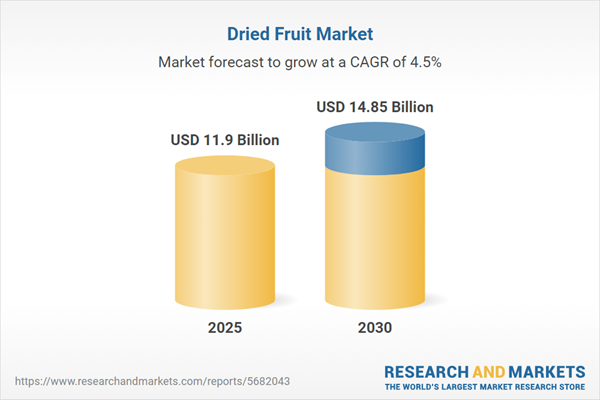Dried fruits are popular globally due to their numerous health benefits and versatility as food inclusions. The expanding food inclusion market is expected to positively influence the growth of the global dried fruits market in the coming years. Dried fruits, which have a longer shelf life compared to fresh fruits, serve as convenient snacks for travel without requiring refrigeration. This extended shelf life is widely recognized and contributes to increasing market demand. Dried fruits are produced by removing nearly all the water content from fresh fruits, resulting in smaller, denser products. Common varieties include raisins, dates, prunes, figs, and apricots, with other options available in sugar-coated or candied forms, such as dried mangoes and cranberries.
Key Drivers of the Dried Fruit Market
- Rising Consumer Awareness of Health Benefits: There is growing recognition among consumers regarding the nutritional advantages of dried fruits. These products are rich in antioxidants, fiber, and vitamins. For example, raisins are known to help manage hypertension and blood glucose levels due to their low to medium glycemic index. Studies suggest that raisins can reduce inflammatory markers and lower cholesterol levels, contributing to a feeling of fullness. With expectations of a 12% increase in raisin production in 2023/24 following the lifting of COVID-19 restrictions in China, demand for dried fruits is likely to rise.
- Convenience for Busy Lifestyles: Dried fruits are increasingly viewed as a substitute for regular meals, particularly during long journeys or when consuming fast food on the go. As lifestyles become busier, consumers prefer portable food options that do not compromise nutritional value. This trend supports strong growth prospects for the global dried fruit market.
- Prevalence of Chronic Diseases: The increasing incidence of chronic diseases is prompting more consumers to incorporate dried fruits into their diets alongside other fruits and vegetables, further driving market growth.
Reasons for buying this report:
- Insightful Analysis: Gain detailed market insights covering major as well as emerging geographical regions, focusing on customer segments, government policies and socio-economic factors, consumer preferences, industry verticals, other sub-segments.
- Competitive Landscape: Understand the strategic maneuvers employed by key players globally to understand possible market penetration with the correct strategy.
- Market Drivers & Future Trends: Explore the dynamic factors and pivotal market trends and how they will shape up future market developments.
- Actionable Recommendations: Utilize the insights to exercise strategic decision to uncover new business streams and revenues in a dynamic environment.
- Caters to a Wide Audience: Beneficial and cost-effective for startups, research institutions, consultants, SMEs, and large enterprises.
What do businesses use our reports for?
Industry and Market Insights, Opportunity Assessment, Product Demand Forecasting, Market Entry Strategy, Geographical Expansion, Capital Investment Decisions, Regulatory Framework & Implications, New Product Development, Competitive Intelligence.Report Coverage:
- Historical data & forecasts from 2022 to 2030
- Growth Opportunities, Challenges, Supply Chain Outlook, Regulatory Framework, Customer Behaviour, and Trend Analysis
- Competitive Positioning, Strategies, and Market Share Analysis
- Revenue Growth and Forecast Assessment of segments and regions including countries
- Company Profiling (Strategies, Products, Financial Information, and Key Developments among others)
The dried fruit market is segmented and analyzed as follows:
- By Type
- Walnuts
- Almonds
- Raisins
- Apricots
- Cashews
- Others
- By Application
- Confectionaries
- Bakery Products
- Dairy Products
- Desserts & Sweets
- Breakfast Cereals
- Others
- By Distribution Channel
- Online
- Offline
- By Geography
- North America
- United States
- Canada
- Mexico
- South America
- Brazil
- Argentina
- Others
- Europe
- United Kingdom
- Germany
- France
- Spain
- Others
- Middle East and Africa
- Saudi Arabia
- UAE
- Israel
- Others
- Asia Pacific
- Japan
- China
- India
- South Korea
- Indonesia
- Thailand
- Others
- North America
Table of Contents
Companies Mentioned
- Royal Nut Company
- Tulsi Nuts and Dryfruits
- Valley Harvest Nut Company
- Seeberger GmbH
- Treehouse Almonds
- Lion Raisins
- Sun-Maid Growers of California
- Geobres
- Vacaville Fruit Company
- KOLLA Group
Table Information
| Report Attribute | Details |
|---|---|
| No. of Pages | 150 |
| Published | January 2025 |
| Forecast Period | 2025 - 2030 |
| Estimated Market Value ( USD | $ 11.9 Billion |
| Forecasted Market Value ( USD | $ 14.85 Billion |
| Compound Annual Growth Rate | 4.5% |
| Regions Covered | Global |
| No. of Companies Mentioned | 10 |









